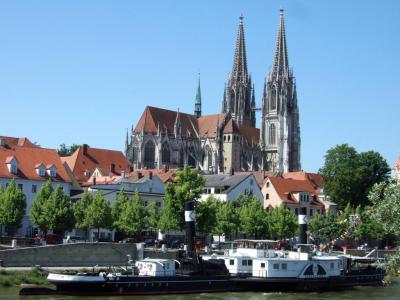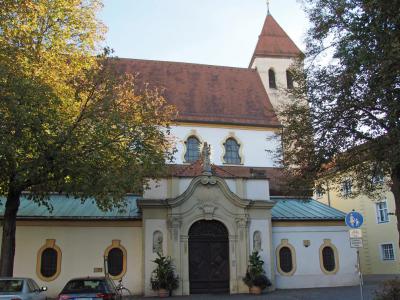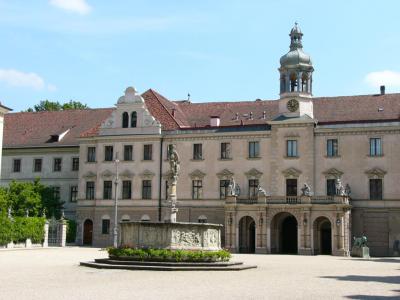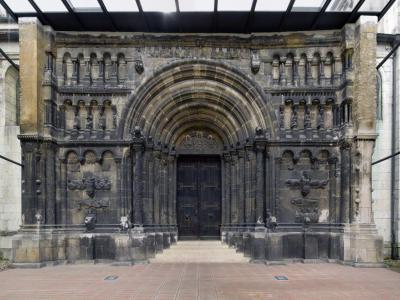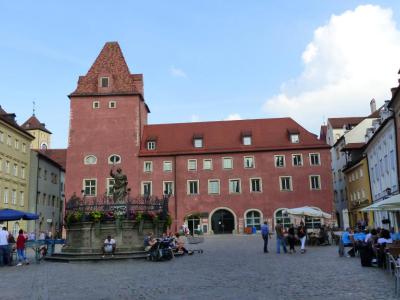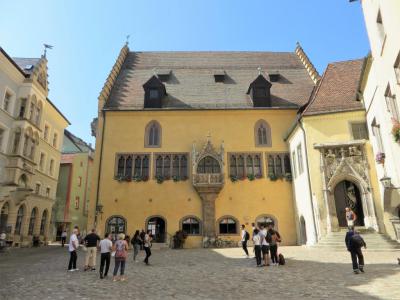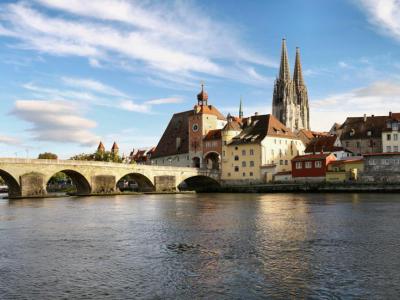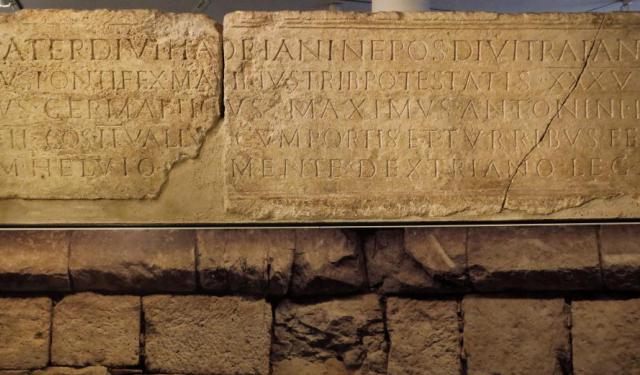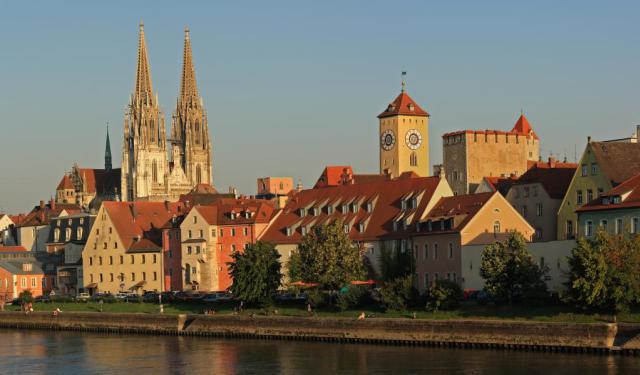
Regensburg Introduction Walking Tour (Self Guided), Regensburg
"The jewel of Bavaria," as some affectionately refer to it, the German city of Regensburg is the biggest medieval site north of the Alps. Although its history spans nearly 2,000 years, here, the past does not seem like a distant memory and its weight blends seamlessly with the pulse of modern life.
The precursor to Regensburg, a military camp called Castra Regina ("Fortress by the River Regen"), was founded by the Romans in 179 AD. The name "Regensburg" is also derived from the River Regen.
Due to its location – at the most northerly point in the course of the Danube where the second longest river in Europe joins forces with the Regen and becomes navigable all the way to the Black Sea, the fort soon evolved into a bustling trading hub.
In the Middle Ages, Regensburg grew in importance as a Free Imperial City of the Holy Roman Empire, known for its thriving commerce and vibrant cultural scene. The Old Stone Bridge (Steinerne Brücke), spanning the Danube River since the 12th century, played a key role in connecting the trade routes and served as a symbol of the city's prosperity. Regensburg was also instrumental in the spread of the Protestant Reformation.
In the 1940s, the city survived the Allied bombing with relatively little damage. Thanks to that, its narrow, winding streets are still lined with colorful Renaissance and Gothic-style buildings such as the Old Town Hall (Altes Rathaus) and the Goliath House (Goliathhaus), as well as picturesque squares like Haid Square (Haidplatz).
The stunning Gothic Regensburg Cathedral is one of the main attractions in Regensburg. Another architectural marvel, Praetorian Gate (Porta Praetoria), once served as the northern entrance to the Castra Regina camp and is one of the oldest remaining Roman structures in Germany, built in the 2nd century AD.
St Emmeram's Abbey: this former Benedictine monastery today serves as a residence for the princely family of Thurn und Taxis. The Regensburg Sausage Kitchen (Historische Wurstküche), dating from the 12th century, is one of the oldest continuously operating restaurants in the world.
If you'd like to hear some tales of forgotten legends told by the ancient facades, while the whispers of the Danube will embrace your senses, Regensburg can offer you that and more. Just follow this self-guided walk and experience it yourself.
The precursor to Regensburg, a military camp called Castra Regina ("Fortress by the River Regen"), was founded by the Romans in 179 AD. The name "Regensburg" is also derived from the River Regen.
Due to its location – at the most northerly point in the course of the Danube where the second longest river in Europe joins forces with the Regen and becomes navigable all the way to the Black Sea, the fort soon evolved into a bustling trading hub.
In the Middle Ages, Regensburg grew in importance as a Free Imperial City of the Holy Roman Empire, known for its thriving commerce and vibrant cultural scene. The Old Stone Bridge (Steinerne Brücke), spanning the Danube River since the 12th century, played a key role in connecting the trade routes and served as a symbol of the city's prosperity. Regensburg was also instrumental in the spread of the Protestant Reformation.
In the 1940s, the city survived the Allied bombing with relatively little damage. Thanks to that, its narrow, winding streets are still lined with colorful Renaissance and Gothic-style buildings such as the Old Town Hall (Altes Rathaus) and the Goliath House (Goliathhaus), as well as picturesque squares like Haid Square (Haidplatz).
The stunning Gothic Regensburg Cathedral is one of the main attractions in Regensburg. Another architectural marvel, Praetorian Gate (Porta Praetoria), once served as the northern entrance to the Castra Regina camp and is one of the oldest remaining Roman structures in Germany, built in the 2nd century AD.
St Emmeram's Abbey: this former Benedictine monastery today serves as a residence for the princely family of Thurn und Taxis. The Regensburg Sausage Kitchen (Historische Wurstküche), dating from the 12th century, is one of the oldest continuously operating restaurants in the world.
If you'd like to hear some tales of forgotten legends told by the ancient facades, while the whispers of the Danube will embrace your senses, Regensburg can offer you that and more. Just follow this self-guided walk and experience it yourself.
How it works: Download the app "GPSmyCity: Walks in 1K+ Cities" from Apple App Store or Google Play Store to your mobile phone or tablet. The app turns your mobile device into a personal tour guide and its built-in GPS navigation functions guide you from one tour stop to next. The app works offline, so no data plan is needed when traveling abroad.
Regensburg Introduction Walking Tour Map
Guide Name: Regensburg Introduction Walking Tour
Guide Location: Germany » Regensburg (See other walking tours in Regensburg)
Guide Type: Self-guided Walking Tour (Sightseeing)
# of Attractions: 11
Tour Duration: 2 Hour(s)
Travel Distance: 4.1 Km or 2.5 Miles
Author: nataly
Sight(s) Featured in This Guide:
Guide Location: Germany » Regensburg (See other walking tours in Regensburg)
Guide Type: Self-guided Walking Tour (Sightseeing)
# of Attractions: 11
Tour Duration: 2 Hour(s)
Travel Distance: 4.1 Km or 2.5 Miles
Author: nataly
Sight(s) Featured in This Guide:
- Regensburg Cathedral
- Porta Praetoria (Praetorian Gate)
- Historische Wurstküche (Regensburg Sausage Kitchen)
- Museum of Bavarian History
- Basilica of the Nativity of Our Lady
- Saint Emmeram's Abbey
- Scots Monastery
- Haidplatz (Haid Square)
- Altes Rathaus (Old Town Hall)
- Goliathhaus (The Goliath House)
- Old Stone Bridge
1) Regensburg Cathedral (must see)
Regensburg Cathedral, also known as the Cathedral of Saint Peter, is renowned for its two towering spires, each reaching a height of 105 meters. The cathedral stands as a testament to Gothic architecture and is hailed as the finest example of a Gothic church in Bavaria.
The exterior of Regensburg Cathedral is adorned with a magnificent west front that dates back to 1395-1440. Its intricate design and meticulous craftsmanship are awe-inspiring, captivating visitors from near and far. The spires, reaching skyward, create an imposing and majestic silhouette that adds to the cathedral's grandeur.
Stepping inside, the spacious interior of the cathedral reveals a captivating beauty. One of its most remarkable features is the stunning collection of 13th- and 14th-century stained glass windows, which fill the space with a kaleidoscope of vibrant colors. Among the highlights are the figures of the Annunciation, dating back to 1280, found on the two western piers of the crossing.
Adjacent to the cathedral, you'll find the exquisite 14th-century cloister, a place of tranquility and contemplation. Here, the Romanesque All Saints Chapel captures attention with its captivating wall paintings, transporting visitors back in time. On the north side of the cathedral stands Saint Stephen's Chapel, a testament to the long history of the site, dating back to 800 CE.
Regensburg Cathedral is also renowned for its boys' choir which has gained international acclaim for its musical excellence. The cathedral's "hanging" organ, the largest of its kind in the world, adds to the auditory splendor experienced within the sacred space.
For those interested in history and art, the Cathedral Treasury is a must-visit. This treasure trove showcases an impressive collection of gold and textiles spanning from the 11th to the 20th century. Each piece is a testament to the craftsmanship and devotion of the individuals who created these precious artifacts.
The exterior of Regensburg Cathedral is adorned with a magnificent west front that dates back to 1395-1440. Its intricate design and meticulous craftsmanship are awe-inspiring, captivating visitors from near and far. The spires, reaching skyward, create an imposing and majestic silhouette that adds to the cathedral's grandeur.
Stepping inside, the spacious interior of the cathedral reveals a captivating beauty. One of its most remarkable features is the stunning collection of 13th- and 14th-century stained glass windows, which fill the space with a kaleidoscope of vibrant colors. Among the highlights are the figures of the Annunciation, dating back to 1280, found on the two western piers of the crossing.
Adjacent to the cathedral, you'll find the exquisite 14th-century cloister, a place of tranquility and contemplation. Here, the Romanesque All Saints Chapel captures attention with its captivating wall paintings, transporting visitors back in time. On the north side of the cathedral stands Saint Stephen's Chapel, a testament to the long history of the site, dating back to 800 CE.
Regensburg Cathedral is also renowned for its boys' choir which has gained international acclaim for its musical excellence. The cathedral's "hanging" organ, the largest of its kind in the world, adds to the auditory splendor experienced within the sacred space.
For those interested in history and art, the Cathedral Treasury is a must-visit. This treasure trove showcases an impressive collection of gold and textiles spanning from the 11th to the 20th century. Each piece is a testament to the craftsmanship and devotion of the individuals who created these precious artifacts.
2) Porta Praetoria (Praetorian Gate)
The Praetorian Gate is an impressive historical landmark and holds the distinction of being Germany's oldest surviving stone building. This ancient gateway, constructed in 179 A.D., stands as a testament to the Roman presence in the region and serves as a reminder of the Roman settlement known as Castra Regina.
Situated in the northern wall of the Roman military camp, the Praetorian Gate was built using massive blocks of stone. Its solid construction has allowed it to endure throughout the centuries, retaining its historical significance. The gateway is strategically positioned, facing the point where the River Regen flows into the Danube, emphasizing its importance in the defense and access of the Roman camp.
Over time, the Praetorian Gate became integrated into subsequent buildings, and its true age and historical significance remained unrecognized until 1885. The gateway's rough-hewn stone blocks provide a glimpse into the architectural techniques and craftsmanship of the Roman period.
The Praetorian Gate stands as an important historical landmark, offering visitors a chance to appreciate the rich history and architectural legacy left by the Romans in Regensburg. Its presence serves as a tangible reminder of the city's Roman origins and provides a fascinating glimpse into the past.
Situated in the northern wall of the Roman military camp, the Praetorian Gate was built using massive blocks of stone. Its solid construction has allowed it to endure throughout the centuries, retaining its historical significance. The gateway is strategically positioned, facing the point where the River Regen flows into the Danube, emphasizing its importance in the defense and access of the Roman camp.
Over time, the Praetorian Gate became integrated into subsequent buildings, and its true age and historical significance remained unrecognized until 1885. The gateway's rough-hewn stone blocks provide a glimpse into the architectural techniques and craftsmanship of the Roman period.
The Praetorian Gate stands as an important historical landmark, offering visitors a chance to appreciate the rich history and architectural legacy left by the Romans in Regensburg. Its presence serves as a tangible reminder of the city's Roman origins and provides a fascinating glimpse into the past.
3) Historische Wurstküche (Regensburg Sausage Kitchen)
The Regensburg Sausage Kitchen is a renowned restaurant located in Regensburg. This eatery holds a special distinction as one of the oldest continuously operating public restaurants in the world.
The origins of the establishment trace back to 1135 AD when a building was constructed as the construction office for the Regensburg stone bridge. Once the bridge was completed in 1146 AD, the building transitioned into a restaurant known as the "cookshop near the crane," owing to its proximity to the river port at that time. Over the centuries, the restaurant became a favorite spot for dockers, sailors, and the workers from the nearby Saint Peter cathedral workshop. While the present building dates back to the 17th century, archaeological evidence indicates the existence of an earlier structure with similar dimensions from the 12th century.
Traditionally, the restaurant's specialty was boiled meat until approximately 1800. However, in 1806, when the current family took over ownership, charcoal-grilled sausages became the main dish served. The Regensburg Sausage Kitchen continues to operate to this day, serving guests from 10 AM to 7 PM (except on holidays) and serving approximately 6,000 sausages daily. The menu prominently features sausages, which are served in portions of six, eight, or ten, accompanied by sauerkraut and mustard. In addition to the sausages, the restaurant offers renowned Bavarian dishes as well as various salads.
During the peak tourist season, guests are often seated outside on wooden benches and tables, as the cozy interior of the tiny building can accommodate only around 35 people.
The origins of the establishment trace back to 1135 AD when a building was constructed as the construction office for the Regensburg stone bridge. Once the bridge was completed in 1146 AD, the building transitioned into a restaurant known as the "cookshop near the crane," owing to its proximity to the river port at that time. Over the centuries, the restaurant became a favorite spot for dockers, sailors, and the workers from the nearby Saint Peter cathedral workshop. While the present building dates back to the 17th century, archaeological evidence indicates the existence of an earlier structure with similar dimensions from the 12th century.
Traditionally, the restaurant's specialty was boiled meat until approximately 1800. However, in 1806, when the current family took over ownership, charcoal-grilled sausages became the main dish served. The Regensburg Sausage Kitchen continues to operate to this day, serving guests from 10 AM to 7 PM (except on holidays) and serving approximately 6,000 sausages daily. The menu prominently features sausages, which are served in portions of six, eight, or ten, accompanied by sauerkraut and mustard. In addition to the sausages, the restaurant offers renowned Bavarian dishes as well as various salads.
During the peak tourist season, guests are often seated outside on wooden benches and tables, as the cozy interior of the tiny building can accommodate only around 35 people.
4) Museum of Bavarian History
The Museum of Bavarian History is a significant cultural institution in Regensburg. Constructed to commemorate the centenary of the Bavarian Free State and the 200th anniversary of the state's constitution, this museum has quickly become one of the country's most important and popular attractions.
Located on the picturesque banks of the Danube River, the Museum of Bavarian History offers a comprehensive exploration of Bavaria's rich history, focusing on the period from the 1800s to modern times. Through state-of-the-art multimedia experiences, visitors can immerse themselves in the captivating stories of generations of Bavarians during this era. The museum utilizes innovative technologies to create engaging and interactive exhibits that bring history to life.
The museum features a diverse range of displays showcasing artifacts, documents, and memorabilia related to Bavarian culture, language, and sports. Visitors can discover the region's traditions, customs, and significant events through carefully curated exhibitions.
The Regensburg Museum of History also houses one of the most extensive permanent exhibitions dedicated to the Roman era in Germany. As visitors embark on their exploration, they will encounter a significant artifact right at the beginning: the slab bearing the fort gate inscription. Originally believed to have been positioned above the entrance of the east gate, this historical slab was discovered in two fragments during excavations on Dachau Square in 1873. The inscription on the slab signifies the year 179, marking the completion of the legionary fort. This inscription serves as Regensburg's foundational certificate and holds immeasurable value in the town's history.
Within the museum, an impressive model showcases the construction of the legionary fortress wall surrounding the Porta Praetoria. This model offers a particularly intriguing glimpse into the building process, illustrating each step from the transportation of ashlar blocks by boat to the riverside, to the meticulous preparation of the stones, and finally to their skillful stacking using cranes.
Located on the picturesque banks of the Danube River, the Museum of Bavarian History offers a comprehensive exploration of Bavaria's rich history, focusing on the period from the 1800s to modern times. Through state-of-the-art multimedia experiences, visitors can immerse themselves in the captivating stories of generations of Bavarians during this era. The museum utilizes innovative technologies to create engaging and interactive exhibits that bring history to life.
The museum features a diverse range of displays showcasing artifacts, documents, and memorabilia related to Bavarian culture, language, and sports. Visitors can discover the region's traditions, customs, and significant events through carefully curated exhibitions.
The Regensburg Museum of History also houses one of the most extensive permanent exhibitions dedicated to the Roman era in Germany. As visitors embark on their exploration, they will encounter a significant artifact right at the beginning: the slab bearing the fort gate inscription. Originally believed to have been positioned above the entrance of the east gate, this historical slab was discovered in two fragments during excavations on Dachau Square in 1873. The inscription on the slab signifies the year 179, marking the completion of the legionary fort. This inscription serves as Regensburg's foundational certificate and holds immeasurable value in the town's history.
Within the museum, an impressive model showcases the construction of the legionary fortress wall surrounding the Porta Praetoria. This model offers a particularly intriguing glimpse into the building process, illustrating each step from the transportation of ashlar blocks by boat to the riverside, to the meticulous preparation of the stones, and finally to their skillful stacking using cranes.
5) Basilica of the Nativity of Our Lady
The Basilica of the Nativity of Our Lady, also known as the Old Chapel, holds a significant place in the religious and architectural history of Regensburg. As the oldest Catholic place of worship in Bavaria, it stands as a testament to the city's rich heritage.
The basilica is part of an ancient abbey that was dedicated to the Virgin Mary and founded by Emperor Henry II, who reigned over the Holy Roman Empire in 1002. The collegiate church, along with its smaller basilica, has played a crucial role in the spiritual life of the community throughout the centuries. Its historical importance and architectural grandeur make it one of the most prominent churches in Regensburg.
The Basilica of the Nativity of Our Lady is known for its Baroque style, which was predominantly developed in the 18th century. It stands as a masterpiece of rococo decoration in Europe, reflecting the influence of the renowned Wessobrunn School. The elaborate and ornate features of the basilica's interior exemplify the opulence and artistic prowess of the rococo period.
The origins of the basilica date back to the time of Charlemagne, who ordered the construction of a chapel on the site. Legend has it that the chapel was built upon the remains of a Roman temple dedicated to Juno. This early chapel, constructed after the decline of the Western Roman Empire, is believed to be the oldest in Bavaria, earning it the nickname the "Old Chapel."
In 1964, Bishop Rudolf Graber proposed the elevation of the Collegiate Church of Our Lady of the Old Chapel to a smaller basilica status, an honor granted by Pope Paul VI. This recognition further solidified the basilica's significance within the Catholic Church.
The basilica is part of an ancient abbey that was dedicated to the Virgin Mary and founded by Emperor Henry II, who reigned over the Holy Roman Empire in 1002. The collegiate church, along with its smaller basilica, has played a crucial role in the spiritual life of the community throughout the centuries. Its historical importance and architectural grandeur make it one of the most prominent churches in Regensburg.
The Basilica of the Nativity of Our Lady is known for its Baroque style, which was predominantly developed in the 18th century. It stands as a masterpiece of rococo decoration in Europe, reflecting the influence of the renowned Wessobrunn School. The elaborate and ornate features of the basilica's interior exemplify the opulence and artistic prowess of the rococo period.
The origins of the basilica date back to the time of Charlemagne, who ordered the construction of a chapel on the site. Legend has it that the chapel was built upon the remains of a Roman temple dedicated to Juno. This early chapel, constructed after the decline of the Western Roman Empire, is believed to be the oldest in Bavaria, earning it the nickname the "Old Chapel."
In 1964, Bishop Rudolf Graber proposed the elevation of the Collegiate Church of Our Lady of the Old Chapel to a smaller basilica status, an honor granted by Pope Paul VI. This recognition further solidified the basilica's significance within the Catholic Church.
6) Saint Emmeram's Abbey (must see)
Saint Emmeram's Abbey has become an increasingly popular tourist destination in recent years, largely due to the restoration of the Thurn und Taxis Palace, of which the abbey is a part.
The abbey has a rich history, dating back to the 7th century when it was founded on the grounds of an ancient Roman structure. The church and abbey complex showcase remarkable architectural features, including a Romanesque porch built in 1170 and a stunning doorway adorned with three 11th-century limestone reliefs. The interior of the abbey is a splendid display of Baroque design and is highly recommended for visitors. It was added in 1733 and houses a collection of magnificent tombs from the 12th to 15th centuries, as well as three crypts.
Another notable attraction within the abbey complex is the Thurn und Taxis Palace, which was constructed in 1739 and completely rebuilt after the destruction caused by World War II. Today, the palace is home to several exceptional museums, including the grand Princely State Rooms. These rooms, designed in the Neo-Renaissance style, feature impressive elements such as a vast marble staircase adjacent to the expansive Baroque ballroom, the exquisite Blue Cabinet and Silver Salon, and a charming conservatory added in the 19th century.
The Carriage Museum, situated in the stables and adjoining riding hall, is another highlight of the abbey complex. Here, visitors can explore a unique collection of carriages and sleighs, offering insights into the transportation history of the region. Additionally, the Princely Treasure Chamber showcases an extensive array of furniture, porcelain, and weaponry, providing a glimpse into the opulence and grandeur of the Thurn und Taxis dynasty.
Saint Emmeram's Abbey and the adjacent Thurn und Taxis Palace serve as vibrant cultural hubs, hosting regular concerts, theatrical performances, and traditional German Christmas markets. These events contribute to the lively atmosphere surrounding the abbey and provide visitors with opportunities to experience the arts and festivities within this historic setting.
The abbey has a rich history, dating back to the 7th century when it was founded on the grounds of an ancient Roman structure. The church and abbey complex showcase remarkable architectural features, including a Romanesque porch built in 1170 and a stunning doorway adorned with three 11th-century limestone reliefs. The interior of the abbey is a splendid display of Baroque design and is highly recommended for visitors. It was added in 1733 and houses a collection of magnificent tombs from the 12th to 15th centuries, as well as three crypts.
Another notable attraction within the abbey complex is the Thurn und Taxis Palace, which was constructed in 1739 and completely rebuilt after the destruction caused by World War II. Today, the palace is home to several exceptional museums, including the grand Princely State Rooms. These rooms, designed in the Neo-Renaissance style, feature impressive elements such as a vast marble staircase adjacent to the expansive Baroque ballroom, the exquisite Blue Cabinet and Silver Salon, and a charming conservatory added in the 19th century.
The Carriage Museum, situated in the stables and adjoining riding hall, is another highlight of the abbey complex. Here, visitors can explore a unique collection of carriages and sleighs, offering insights into the transportation history of the region. Additionally, the Princely Treasure Chamber showcases an extensive array of furniture, porcelain, and weaponry, providing a glimpse into the opulence and grandeur of the Thurn und Taxis dynasty.
Saint Emmeram's Abbey and the adjacent Thurn und Taxis Palace serve as vibrant cultural hubs, hosting regular concerts, theatrical performances, and traditional German Christmas markets. These events contribute to the lively atmosphere surrounding the abbey and provide visitors with opportunities to experience the arts and festivities within this historic setting.
7) Scots Monastery (must see)
The Scots Monastery is a historic Benedictine Abbey of Saint James. Founded in the 11th century by Irish missionaries, the monastery was predominantly occupied by Irish monks initially and later by Scottish monks. The official name of the monastery church is "The Irish Benedictine Abbey Church of St. James and St. Gertrude."
Originally constructed to the south of the city walls around 1070, the abbey soon became too small to accommodate the growing number of Irish monks. As a result, a new site was acquired outside the western city gate, and construction of a new abbey began around 1100. Around 1300, as the city walls were extended, St. James became integrated into the fortified city, and the adjacent western gate came to be known as the Jakob Tower.
The first abbey church, built at the beginning of the 11th century, was a three-aisled basilica with three apses. While only the eastern end of this building, including the apses and two flanking towers, remains intact, traces of the western wall have been discovered, suggesting that the original structure was shorter but of similar width to the present building.
A new church, which largely survives to this day, was constructed between 1175 and 1180. It exemplifies Romanesque architecture, featuring a three-aisled basilica with three apses, towers at the eastern end, and a transept at the western end. The transept houses a gallery that spans all three aisles and now houses an organ.
The most renowned architectural feature of the church is its north portal, known as the Scottish portal. Occupying a third of the north wall, the portal is lavishly adorned with ornamental and figural sculptures.
The interpretation of the sculptural program on the Scottish portal has been a subject of debate since the early 19th century. The portal is divided into three horizontal and three vertical sections. The lower level showcases a richly decorated doorway flanked by relief sculptures on flat fields. The middle level comprises a tympanum and archivolt in the center, with blind arcades adorned with caryatids on either side. The upper level depicts a frieze depicting Christ and the twelve apostles at the center, flanked by figureless blind arcades on both sides.
Originally constructed to the south of the city walls around 1070, the abbey soon became too small to accommodate the growing number of Irish monks. As a result, a new site was acquired outside the western city gate, and construction of a new abbey began around 1100. Around 1300, as the city walls were extended, St. James became integrated into the fortified city, and the adjacent western gate came to be known as the Jakob Tower.
The first abbey church, built at the beginning of the 11th century, was a three-aisled basilica with three apses. While only the eastern end of this building, including the apses and two flanking towers, remains intact, traces of the western wall have been discovered, suggesting that the original structure was shorter but of similar width to the present building.
A new church, which largely survives to this day, was constructed between 1175 and 1180. It exemplifies Romanesque architecture, featuring a three-aisled basilica with three apses, towers at the eastern end, and a transept at the western end. The transept houses a gallery that spans all three aisles and now houses an organ.
The most renowned architectural feature of the church is its north portal, known as the Scottish portal. Occupying a third of the north wall, the portal is lavishly adorned with ornamental and figural sculptures.
The interpretation of the sculptural program on the Scottish portal has been a subject of debate since the early 19th century. The portal is divided into three horizontal and three vertical sections. The lower level showcases a richly decorated doorway flanked by relief sculptures on flat fields. The middle level comprises a tympanum and archivolt in the center, with blind arcades adorned with caryatids on either side. The upper level depicts a frieze depicting Christ and the twelve apostles at the center, flanked by figureless blind arcades on both sides.
8) Haidplatz (Haid Square)
Haid Square, located at the heart of the old town, is a vibrant triangular square that bears witness to the medieval jousting tournaments of the past.
Standing prominently in the square is the fortress-like Golden Cross, a patrician house with origins dating back to the 13th century. This remarkable building has hosted a multitude of notable figures throughout history, including the esteemed Holy Roman Emperor Charles V, who graced its halls on three separate occasions during the 1530s and 40s.
Another notable structure that catches the eye is the "New Scales", a former burgher house that was acquired by the city in the 15th century and transformed into a weighing house. The arcades on the lower floor, now adorned with glass, have stood since 1575, serving as a testament to the passage of time and the architectural prowess of the era.
At the center of Haid Square stands the Justice Fountain dating back to 1656. This historic fountain, once a vital water source supplied by a conduit stretching from the village of Dechbetten in the western part of the city, now serves as a captivating centerpiece.
Standing prominently in the square is the fortress-like Golden Cross, a patrician house with origins dating back to the 13th century. This remarkable building has hosted a multitude of notable figures throughout history, including the esteemed Holy Roman Emperor Charles V, who graced its halls on three separate occasions during the 1530s and 40s.
Another notable structure that catches the eye is the "New Scales", a former burgher house that was acquired by the city in the 15th century and transformed into a weighing house. The arcades on the lower floor, now adorned with glass, have stood since 1575, serving as a testament to the passage of time and the architectural prowess of the era.
At the center of Haid Square stands the Justice Fountain dating back to 1656. This historic fountain, once a vital water source supplied by a conduit stretching from the village of Dechbetten in the western part of the city, now serves as a captivating centerpiece.
9) Altes Rathaus (Old Town Hall)
The Old Town Hall holds the distinction of being the oldest town hall in Regensburg. Its construction began in the 11th century, and although it is now part of the new town hall complex, it stands out as a significant attraction in its own right. The yellow-hued structure carries a rich history, having served as the venue for Roman assemblies from 1594 to 1806. Exploring its various rooms offers visitors a deeper understanding of its historical significance.
One of the notable chambers within the Old Town Hall is where the Roman historical Diet convened. This chamber has been meticulously preserved and stands as one of the top tourist attractions in Regensburg. Visitors can admire the well-preserved wall decorations and the throne designated for the emperor.
Venturing to the upper part of the building reveals a collection of unique rooms, each with its own character and historical significance. However, it is in the lower levels where the dungeons are located, once used to confine prisoners. These subterranean chambers offer a glimpse into the darker side of the town hall's history.
One of the notable chambers within the Old Town Hall is where the Roman historical Diet convened. This chamber has been meticulously preserved and stands as one of the top tourist attractions in Regensburg. Visitors can admire the well-preserved wall decorations and the throne designated for the emperor.
Venturing to the upper part of the building reveals a collection of unique rooms, each with its own character and historical significance. However, it is in the lower levels where the dungeons are located, once used to confine prisoners. These subterranean chambers offer a glimpse into the darker side of the town hall's history.
10) Goliathhaus (The Goliath House)
The Goliath House is a captivating historic building that boasts a remarkable mural depicting the biblical story of David and Goliath. This unique artwork is one of the highlights of the house and serves as an enticing attraction for visitors exploring the city.
Dating back to 1260, the Goliath House has a long and fascinating history. During that time, the area housed a significant Roman camp, providing shelter for hundreds of Roman soldiers. The patrician house itself was constructed in the southern part of the camp and has stood as a prominent structure for centuries.
The mural depicting David and Goliath is not a recent addition but was created by Melchior Bocksberger in 1573. Bocksberger, an artist from Salzburg, was responsible for this captivating artwork that has become an integral part of the building's identity. The Goliath House was once home to the Goliards' clergy, a group known for their satirical poetry during that era.
Today, the Goliath House is a popular tourist attraction, drawing visitors with its fascinating history and the impressive mural. Additionally, the building houses a restaurant on its top floor, offering visitors a delightful culinary experience. Dining at this restaurant allows guests to savor some of Germany's finest delicacies while enjoying the unique atmosphere of this historic location.
Dating back to 1260, the Goliath House has a long and fascinating history. During that time, the area housed a significant Roman camp, providing shelter for hundreds of Roman soldiers. The patrician house itself was constructed in the southern part of the camp and has stood as a prominent structure for centuries.
The mural depicting David and Goliath is not a recent addition but was created by Melchior Bocksberger in 1573. Bocksberger, an artist from Salzburg, was responsible for this captivating artwork that has become an integral part of the building's identity. The Goliath House was once home to the Goliards' clergy, a group known for their satirical poetry during that era.
Today, the Goliath House is a popular tourist attraction, drawing visitors with its fascinating history and the impressive mural. Additionally, the building houses a restaurant on its top floor, offering visitors a delightful culinary experience. Dining at this restaurant allows guests to savor some of Germany's finest delicacies while enjoying the unique atmosphere of this historic location.
11) Old Stone Bridge (must see)
The Old Stone Bridge is a magnificent 12th-century bridge located in Regensburg. Spanning across the Danube River, it connects the Old Town of Regensburg with the district of Stadtamhof. For over 800 years, from its construction until the 1930s, it served as the city's sole river crossing, making it a significant symbol of Regensburg's history and heritage.
The Stone Bridge is a testament to medieval engineering and craftsmanship, considered a masterwork of construction from its time. It stands as an iconic landmark and a source of pride for the city. The southern end of the bridge is believed to have been the location of an ancient city gate, adding to its historical significance.
Walking along the 310-meter-long Old Stone Bridge, you will be treated to breathtaking views of Regensburg. As the oldest bridge of its kind in Europe, it carries a rich history within its ancient stones. Now exclusively open for pedestrian traffic, it offers an idyllic vantage point to admire the flowing Danube River and observe the numerous tourist and pleasure boats passing beneath.
The Stone Bridge is a testament to medieval engineering and craftsmanship, considered a masterwork of construction from its time. It stands as an iconic landmark and a source of pride for the city. The southern end of the bridge is believed to have been the location of an ancient city gate, adding to its historical significance.
Walking along the 310-meter-long Old Stone Bridge, you will be treated to breathtaking views of Regensburg. As the oldest bridge of its kind in Europe, it carries a rich history within its ancient stones. Now exclusively open for pedestrian traffic, it offers an idyllic vantage point to admire the flowing Danube River and observe the numerous tourist and pleasure boats passing beneath.
Walking Tours in Regensburg, Germany
Create Your Own Walk in Regensburg
Creating your own self-guided walk in Regensburg is easy and fun. Choose the city attractions that you want to see and a walk route map will be created just for you. You can even set your hotel as the start point of the walk.
Roman Ruins Walking Tour
Meandering through the Old Town of Regensburg, it’s easy to forget that some 1800 years ago most of this area was occupied by a Roman fortress. Although the first settlement here dates from as early as the Stone Age, it is the Romans who put it firmly on the map.
Around 90 AD, they first built an expeditionary and then a permanent military camp called Castra Regina ("Fortress by the... view more
Tour Duration: 1 Hour(s)
Travel Distance: 1.4 Km or 0.9 Miles
Around 90 AD, they first built an expeditionary and then a permanent military camp called Castra Regina ("Fortress by the... view more
Tour Duration: 1 Hour(s)
Travel Distance: 1.4 Km or 0.9 Miles
The Most Popular Cities
/ view all
